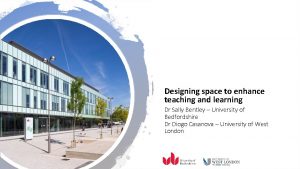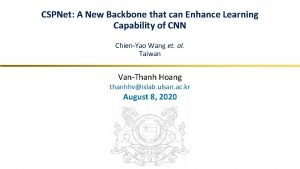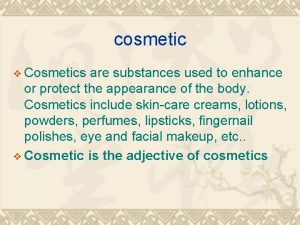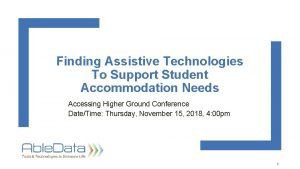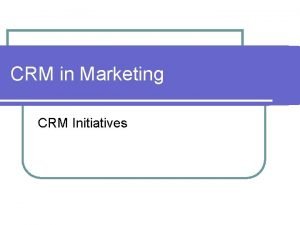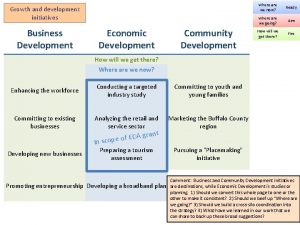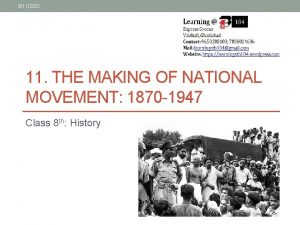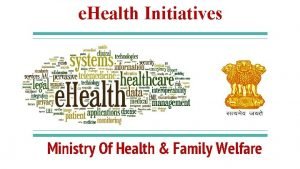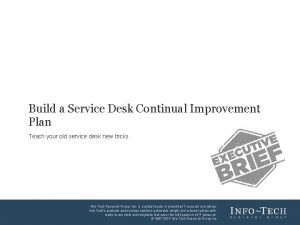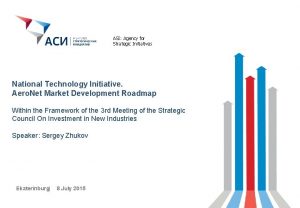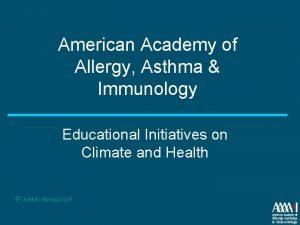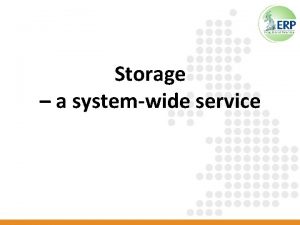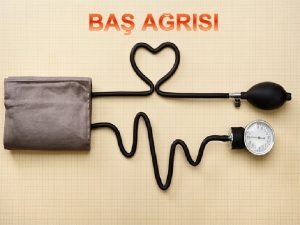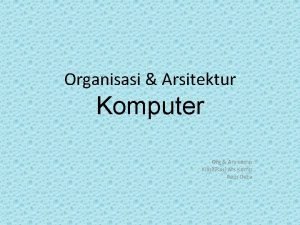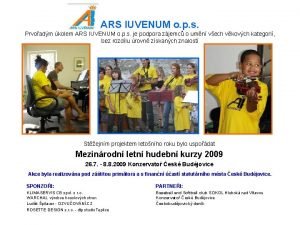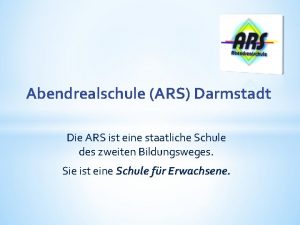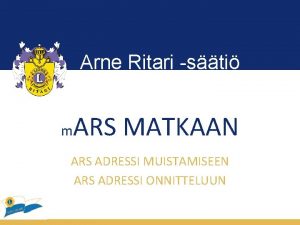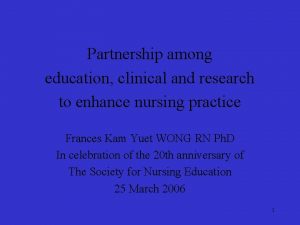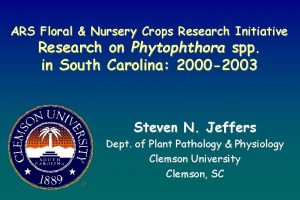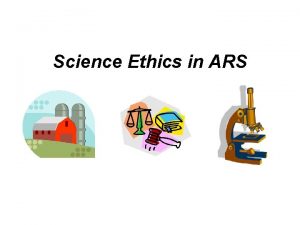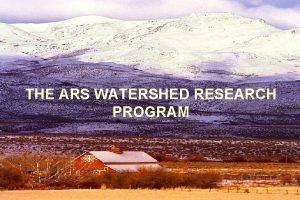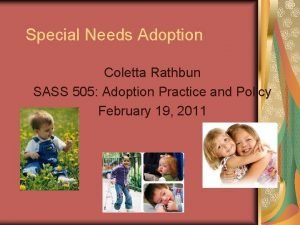Partnership Initiatives to Enhance ARS Research Adoption of






























- Slides: 30

Partnership Initiatives to Enhance ARS Research & Adoption of Outcomes --- Science-based Innovations for Public Benefit --Richard J. Brenner, Ph. D. Assistant Administrator of ARS for Technology Transfer Office of Technology Transfer NACOP Workshop Norman, OK August 17 -19, 2010

A Partnership Initiative… This is all about relationships, … building trust, … and developing efficient processes to serve… ARS SCIENTISTS … and is shaped by the issues, needs, & concerns of scientists, line, and program managers

Starting with some Definitions & Goals… “Partnerships” … …relationships that facilitate research and outcomedelivery with any entity outside of the Management Unit or local ARS (location / Area) research environment. Overarching goals of Partnership Initiative: 1. 2. 3. 4. Strengthened research capabilities through partnerships More $$ to the bench (discretionary) More time to conduct research (e. g. , reduced administrative burdens and enhanced assistance to scientists, Unit, Location, Area) Greater impact from research outcomes, and documenting value of investing in ARS.

Topics for Discussion -- uniformity & efficiency -- Overarching goals of Partnership Initiative: 1. Strengthened research capabilities through partnerships Ø Nurturing our relationships with university partners Ø What strengths do they provide to ARS? Ø What unique strengths does ARS contribute? Ø Are we forming optimal teams of comprehensive research expertise? Ø To what extent can we operate uniformly & predictably across the agency?

Mechanisms / Partnerships to Increase Extramural Funds to ARS Bench Ø Competitive Grants (AFRI, SCRI, NSF, NIH, Do. E, foundations) Ø Focused public sector partnerships on high priority areas. Some examples…. Ø Local / regional / urban agriculture Ø Ø Ø Land management / sustainable environmental practices Ø Ø Ø EPA / Do. C / Dept of Labor, / DOT, Do. D, HUD, NIFA Council of Governors, Council of Mayors Do. E – bioenergy Urban planning (states, counties, cities) Do. D (BRACs and current bases in operations) Do. I – Reclamation, U. S. Geologic Survey Job Creation and Entrepreneurship in rural America Ø Dept. of Commerce, Economic Development, Office of Innovation and Entrepreneurship; Small Business Administration

Mechanisms / Partnerships to Increase Extramural Funds to ARS Bench Focused public / private sector partnerships on high priority areas such as… Ø Nutrition and health (includes genomics) Pharmaceutical corporations; NIH Ø Nutritional products Ø Asthma and allergy foundations, others… / private sector firms Ø Ø Preventive medicine & preventive measures Disease prevention / personal protection Ø Protecting the warfighter (repellents) Ø Detection technologies for emerging pathogens (plants, food animals, reservoir animals, humans) Ø

Topics for Discussion -- uniformity & efficiency -Overarching goals of Partnership Initiative: 1. 2. Strengthened research capabilities through partnerships More $$ to the bench (discretionary) Ø Do we adequately capture our actual costs of executing the research? (facilities? , energy? ) Ø Other direct costs? Ø Are we capturing actual indirect costs? Ø Are we expeditiously delivering $$ to the scientists?

Topics for Discussion -- uniformity & efficiency -- Overarching goals of Partnership Initiative: 1. 2. 3. Strengthened research capabilities through partnerships More $$ to the bench (discretionary) More time to conduct research (e. g. , reduced administrative burdens and enhanced assistance to scientists, Unit, Location, Area) Ø Capturing & relaying info on funding opportunities? Grantsmanship assistance… Ø Simplifying approval processes; negotiating SOW / terms & conditions of partnerships Ø Tracking submissions; monitoring performance

Topics for Discussion -- uniformity & efficiency -Overarching goals of Partnership Initiative: 1. 2. 3. 4. Strengthened research capabilities through partnerships More $$ to the bench (discretionary) More time to conduct research (e. g. , reduced administrative burdens and enhanced assistance to scientists, Unit, Location, Area) Greater impact from research outcomes, and documenting value of investing in ARS. Ø Increasing likelihood that research outcomes will be adopted by end users Ø Valuation of outcomes

Early Priorities for a “Partnerships & Innovations” Initiative in ARS Ø Ø Ø Capturing & relaying info on funding opportunities Providing grantsmanship training and assistance in preparing all aspects of the proposal packet Establishing partnerships through a simplified – but well coordinated -- approval process; Ø Ø Coordinating SOW / terms & conditions of partnerships Tracking submissions; monitoring performance

Importance of University / Private Sector Collaborators & Cross-Area Partnerships with ARS: Some FY 2009 Metrics Ø Licenses Ø Current active: 301 (316 were active during FY) --129 with commercial products in the market Ø Universities – 118 (39%) Ø Non-profits – 17 (6%) Ø Small Businesses – 105 (35%) Ø Foreign businesses (no U. S. presence) – 7 (2%) Ø Large businesses (includes foreign multinationals with major U. S. presence) – 54 (18%) Ø CRADAs Ø Active 233 (during FY 2009) Ø Domestic companies – 217 (93%; ca. 62% small business) Ø Outside state of researcher – 167 (72%) Ø Out of ARS Area of researcher – 133 (57%)

Model of a Public/Private Partnership for Commercialization of Research Outcomes Structural Assets and Financial Resources Product Registration Expertise Technical Expertise— Product Dev, Scale-up, QC Intellectual Property Fiscal Resources Intellectual Assets CRADA (required for federal license) Marketing & Distribution Capabilities Human Capital Complementary Assets Manufacturing Capacity Intellectual Capital T 2 These can be facilitated by Partnership Intermediaries of ARS (TBED entities) linked to mission priorities Adapted from Sullivan, P. H. , Profiting From Intellectual Capital, John Wiley & Sons, New York, 2000. 12

ARS Agricultural Technology Innovation Partnership Program (ATIP)

Concept & Strategy for Agricultural Technology Innovation Partnership Program --through Partnership Intermediary Agreements (PIA) -- To partner with selected economic development entities that can enhance the effectiveness of the ARS technology transfer program and expand its impact To enhance the flow of ARS technologies and research outcomes to small and expanding businesses and to encourage technology-based economic development To provide complementary business assets and business expertise to private sector partners of ARS

Goals of ARS Partnership Intermediaries Provide complementary assets to ARS Office of Technology Transfer Ø Guide local / regional business with research needs to the appropriate ARS scientist across ARS (CRADA opportunities) Ø Triage business plans of private sector to seek “winners” as candidates for licensing / research partnerships with ARS Ø Acquire marketing assessments on ARS technologies from 3 rd party sources (business schools, entrepreneur programs, angel investors, etc. ) for targeted marketing Ø Coordinate “Technology Showcase” events to facilitate partnerships with private sector companies (TEDCO, October 30, 2008 – Four Points Sheraton at BWI)

Goals of ARS Partnership Intermediaries Provide complementary assets needed by private sector to succeed in commercializing federal inventions Ø Assist in accessing public / private funds Ø SBIR proposals Ø Angel investors / state funds Ø Manufacturing capacity Ø Manage their own seed/venture funds or networks to support CRADA and license partners of ARS Ø Assist in problem solving manufacturing capacity Ø Network with other ATIP members and other federal PIA networks.

Building the ATIP Program Envisioned as providing an efficient network for ARS with each member serving as a conduit to a greater number of local, regional (e. g. , county), or state entities, including venture capitalists and angel investors. Because of the need for regional access to private sector companies and resources for sustained economic development, ATIP is likely to have optimal effectiveness with at least 8 PIA partners, strategically distributed across the country in partnership with each Area.

Agricultural Technology Innovation Partnership Network

Early Success from ATIP (TEDCO) … Rice-based frying batter, “Choice Batter” gluten free, absorbs 50% less oil (Fred Shih, New Orleans, LA) Crisp. Tek, LLC • TEDCO-facilitated marketing plan • ARS Licensed 4 April 2008 • TEDCO support October 2008 (MTTCF) • First sale, 3 May 2009 • Internet sales; 300 stores; 3 food companies

Leveraging the Assets of Partnership Intermediaries of ARS

The Innovation Ecosystem to Promote Technology Transfer from USDA ATIP is uniquely positioned to serve Secretary Vilsack in supporting goals of other USDA agencies as well as other federal Departments with common interests, thereby reflecting a leadership role of USDA in the Executive Branch Ø Ø Ø Local / regional agriculture production (know your farmer, know your food) Bioenergy and opportunities for entrepreneurs to create wealth in rural communities Food security (national / international; emerging zoonotic / plant diseases) Food safety Nutrition and childhood obesity 21

The Innovation Ecosystem to Promote Technology Transfer from USDA The White House Innovation & Entrepreneurship working group has recognized ATIP as a “…novel and impressive federal model…” for facilitating commercialization of technologies from federal labs Seeking ways to promote innovation and job creation using existing authorities and appropriations � E. g. , SBIR and proposed SBIR-TT model � Regional / virtual proof of concept centers � Cross-sector partnerships ATIP members (10) convened their inaugural workshop 21 June 2010 to begin formulating strategies to address some of Secretary Vilsack’s priorities consistent with ARS mission ATIP was joined on 22 June 2010 by the comparable national intermediary network of Do. D (7 members) to identify and address areas of common interest to Do. D and USDA (supporting Sec. Vilsack’s goals) 22

Do. D PIA Network Members

A Joint Workshop of Members of the USDA ARS Agricultural Technology Innovation Partnership (ATIP) Program, and Members of Do. D’s Office of Technology Transition Partnership Intermediary Network (OTTPIN) June 21, 2010 Beltsville Agricultural Research Center (ATIP members) June 22, 2010 Beltsville Agricultural Research Center (ATIP & OTTPIN members) 24

A USDA / Do. D Partnership… ARS ATIP and Do. D’s OTTPIN reached agreement to formalize interactions to create a new model to facilitate public/private partnerships for sustainable economic development and to address common interests of Do. D and USDA. Example projects may include: Ø Local / regional food production in cities and Do. D installations Ø Distributed bioenergy production from biomass Ø Zoonotics & emerging diseases Ø Health & nutrition of Do. D personnel and dependents


Showcases to Highlight Research Outcomes and Capabilities Hosted by Intermediaries (ATIP) each geographically convened, and each themed to one of the five priorities Ø Climate Change (mitigation & adaptation) Ø Bioenergy (sustainability & economic viability) Ø Nutrition and Health (nutritious & convenient) Ø Food Safety (reduce pathogens through detection & suppression) Ø International Food Security (sustainable, efficient, local)

This is all about relationships… …and building trust INSTIT UTION H C R A P S RIVAT SE E R E SEC TY I S S R E TOR R E V I N N T U AR NURTURING P / G N TI N A GR NG I D FUN CIES N E G A NURTURING RELATIONSHIPS ARS Scientists LINE MANAGEMENT PROGRAM MANAGEMENT FEDERAL R&D PARTNERS ADMINISTRATIVE MANAGEMENT

The Office of Technology Transfer …. … promoting the adoption of ARS research outcomes Richard J. Brenner, Ph. D. Assistant Administrator Office of Technology Transfer 5601 Sunnyside Ave Beltsville, MD 20705 (301) 504 -6905 Photo: Quiet Waters Park, Annapolis, MD (Joann Perkins) http: //www. ars. usda. gov/Business. htm 29

The Innovation Ecosystem to Promote Technology Transfer from USDA The Agricultural Technology Innovation Partnership program (ATIP) is a network of intermediaries established by ARS to fast-track adoption by the private sector of research outcomes (science-based innovations) to facilitate sustainable economic development Ø Members are accomplished economic development organizations, commodity independent, and geographically strategic Ø Strong links to universities, state/local governments, multiple federal agencies Ø Provide complementary assets needed for businesses to succeed domestically, compete globally, while furthering the innovation initiative of the Administration and key specific priorities of the Secretary of Agriculture 30
 Grammar to enrich and enhance writing
Grammar to enrich and enhance writing A particular or unique version of a style is a
A particular or unique version of a style is a Enhance an image
Enhance an image Cspnet
Cspnet Cosmetics are substances that are used to enhance……..
Cosmetics are substances that are used to enhance…….. Enhance an image
Enhance an image Nyjc subject combination
Nyjc subject combination Enhance life
Enhance life Salad that stimulate the appetite of your guests
Salad that stimulate the appetite of your guests Can hypnosis enhance recall of forgotten events
Can hypnosis enhance recall of forgotten events Delvic sanitation initiatives
Delvic sanitation initiatives Digital initiatives in higher education
Digital initiatives in higher education Crm initiatives
Crm initiatives Johannes volkelt theory health and social care
Johannes volkelt theory health and social care Business development initiatives
Business development initiatives People's initiatives
People's initiatives Nasa access management system (nams)
Nasa access management system (nams) Health initiatives
Health initiatives Service improvement plan for service desk
Service improvement plan for service desk Us soccer player development initiatives
Us soccer player development initiatives Global health initiatives meaning
Global health initiatives meaning Flexible working presentation
Flexible working presentation Faa runway safety
Faa runway safety Oakland affordable housing preservation initiatives
Oakland affordable housing preservation initiatives Ottawa charter pdhpe
Ottawa charter pdhpe Agency for strategic initiatives
Agency for strategic initiatives American academy of allergy asthma and immunology 2018
American academy of allergy asthma and immunology 2018 International cancer research partnership
International cancer research partnership Energy research partnership
Energy research partnership Pagwash
Pagwash Poema ars
Poema ars


